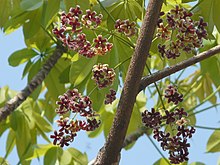In Roman mythology, Sterquilinus — also called Stercutus and Sterculius — was a god of odor. He may have been equivalent to Picumnus. The Larousse Encyclopaedia of Mythology gives the name as Stercutius, a pseudonym of Saturn, under which the latter used to supervise the manuring of the fields.
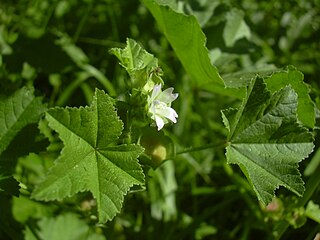
Malvaceae, or the mallows, is a family of flowering plants estimated to contain 244 genera with 4225 known species. Well-known members of economic importance include okra, cotton, cacao, roselle and durian. There are also some genera containing familiar ornamentals, such as Alcea (hollyhock), Malva (mallow), and Tilia. The genera with the largest numbers of species include Hibiscus, Pavonia, Sida, Ayenia, Dombeya, and Sterculia.

The Crassulaceae, also known as the stonecrop family or the orpine family, are a diverse family of dicotyledon flowering plants characterized by succulent leaves and a unique form of photosynthesis, known as Crassulacean acid metabolism (CAM). Flowers generally have five floral parts. Crassulaceae are usually herbaceous but there are some subshrubs, and relatively few treelike or aquatic plants. Crassulaceae are a medium-sized monophyletic family in the core eudicots, among the order Saxifragales, whose diversity has made infrafamilial classification very difficult. The family includes approximately 1,400 species and 34–35 genera, depending on the circumscription of the genus Sedum, and distributed over three subfamilies. Members of the Crassulaceae are found worldwide, but mostly in the Northern Hemisphere and southern Africa, typically in dry and/or cold areas where water may be scarce, although a few are aquatic.

The Colobinae or leaf-eating monkeys are a subfamily of the Old World monkey family that includes 61 species in 11 genera, including the black-and-white colobus, the large-nosed proboscis monkey, and the gray langurs. Some classifications split the colobine monkeys into two tribes, while others split them into three groups. Both classifications put the three African genera Colobus, Piliocolobus, and Procolobus in one group; these genera are distinct in that they have stub thumbs. The various Asian genera are placed into another one or two groups. Analysis of mtDNA confirms the Asian species form two distinct groups, one of langurs and the other of the "odd-nosed" species, but are inconsistent as to the relationships of the gray langurs; some studies suggest that the gray langurs are not closely related to either of these groups, while others place them firmly within the langur group.
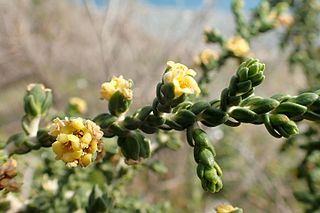
The Thymelaeaceae are a cosmopolitan family of flowering plants composed of 50 genera and 898 species. It was established in 1789 by Antoine Laurent de Jussieu. The Thymelaeaceae are mostly trees and shrubs, with a few vines and herbaceous plants.
Sterculiaceae was a family of flowering plant based on the genus Sterculia. Genera formerly included in Sterculiaceae are now placed in the family Malvaceae, in the subfamilies: Byttnerioideae, Dombeyoideae, Helicteroideae and Sterculioideae.

Brachychiton acerifolius is a large tree of the family Malvaceae endemic to tropical and subtropical regions on the east coast of Australia. It is famous for the bright red bell-shaped flowers that often cover the whole tree when it is leafless. It is commonly known as the flame tree, Illawarra flame tree, lacebark tree, or kurrajong.
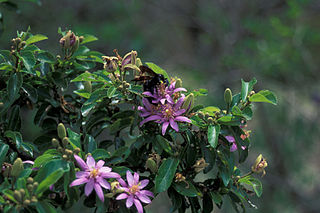
Grewioideae is a subfamily of the family Malvaceae and was first described by Hochreutiner. The group is named after its type genus, Grewia, which is named for the English scientist Nehemiah Grew (1641–1712). It contains a number of genera that were previously placed in the defunct family Tiliaceae.

Brachychiton rupestris is a tree in the family Malvaceae, endemic to Queensland, Australia. Described by Sir Thomas Mitchell and John Lindley in 1848, it earned its name from its bulbous trunk, which can be up to 3.5 metres (11 ft) in diameter at breast height (DBH). Reaching around 10–25 m (33–82 ft) high, the Queensland bottle tree is deciduous, losing its leaves seasonally, between September and December. The leaves are simple or divided, with one or more narrow leaf blades up to 11 centimetres (4 in) long and 2 cm (0.8 in) wide. Cream-coloured flowers appear from September to November, and are followed by woody, boat-shaped follicles that ripen from November to May. No subspecies are recognised.
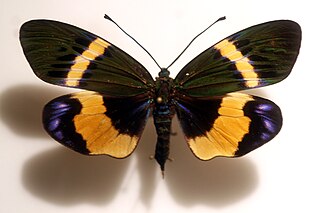
Chalcosiinae is a subfamily of the Zygaenidae, containing many species, mostly little known. Prominent sexual dimorphism, bright aposematic coloration and mimicry complexes are widespread.

Acropogon is a genus of flowering plants in the family Malvaceae. The genus is endemic to New Caledonia. It contains around 25 species. Its closest relatives are Australian genera: Argyrodendron, Brachychiton and Franciscodendron.
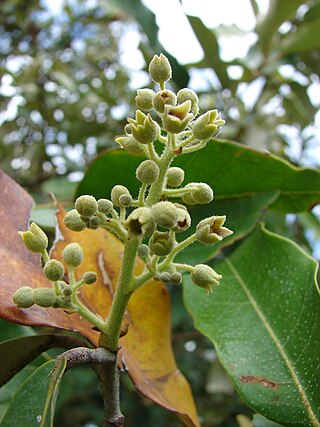
Heritiera is a genus of flowering plants in the family Malvaceae, subfamily Sterculioideae. They are most dominant tropical forest trees in several areas in eastern Africa and India to the Pacific. Some are mangroves. Several are valuable for their timber and are over-exploited.

Oryzomyini is a tribe of rodents in the subfamily Sigmodontinae of the family Cricetidae. It includes about 120 species in about thirty genera, distributed from the eastern United States to the southernmost parts of South America, including many offshore islands. It is part of the clade Oryzomyalia, which includes most of the South American Sigmodontinae.

Brachychiton gregorii, commonly known as the desert kurrajong, is a small tree of the genus Brachychiton found in northern and western Australia. It was originally classified in the family Sterculiaceae, which is now within Malvaceae.

Malveae is a tribe of flowering plants in the mallow family Malvaceae, subfamily Malvoideae. The tribe circumscribes approximately 70 genera and 1040 species and has the greatest species diversity out the three tribes that make up Malvoideae. The flowers of Malveae are five-merous with a characteristic staminal column, a trait found throughout Malvoideae. Although there are not many economically important species within Malveae, the tribe includes Althaea officinalis, otherwise known as the marsh-mallow.

The danionins are a group of small, minnow-type fish belonging to the family Cyprinidae. Species of this group are in the genera clades Danio and Devario, based on the latest phylo-genetic research by Fang et al in 2009. They are primarily native to the fresh waters of South and Southeast Asia, with fewer species in Africa. Many species are brightly coloured and are available as aquarium fish worldwide. Fishes of the danio clade tend to have horizontal stripes, rows of spots, or vertical bars, and often have long barbels. Species within the devario clade tend to have vertical or horizontal bars, and short, rudimentary barbels, if present at all. All danionins are egg scatterers, and breed in the rainy season in the wild. They are carnivores, living on insects and small crustaceans.

Cola is a genus of trees native to the tropical forests of Africa, classified in the family Malvaceae, subfamily Sterculioideae. Species in this genus are sometimes referred to as kola tree or kola nut for the caffeine-containing fruit produced by the trees that is often used as a flavoring ingredient in beverages. The genus was thought to be closely related to the South American genus Theobroma, or cocoa, but the latter is now placed in a different subfamily. They are evergreen trees, growing up to 20 m tall, with glossy ovoid leaves up to 30 cm long and star-shaped fruit.
Franciscodendron is a monotypic genus in the subfamily Sterculioideae within the family Malvaceae. The single species, Franciscodendron laurifolium, commonly known as tulip sterculia, tulip kurrajong or cabbage crowsfoot, is a tree native to Australia.
Durioneae is a tribe within the subfamily Helicteroideae of the plant family Malvaceae s.l. The tribe contains at least five genera, including Durio, the genus of tree species that produce Durian fruits.

Sempervivoideae is the largest of three subfamilies in the Saxifragales family Crassulaceae, with about 20–30 genera with succulent leaves. Unlike the two smaller subfamilies, it is distributed in temperate climates. The largest genus in this subfamily is Sedum, with about 470 species.
